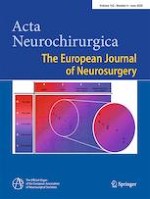Erschienen in:

26.02.2020 | Original Article - Tumor - Meningioma
A clinical study of ocular motor nerve functions after petroclival meningioma resection
verfasst von:
Liang Wang, Qing Zhang, Jian-Cong Weng, Liang-Peng Chen, Da Li, Gui-Jun Jia, Li-Wei Zhang, Zhen Wu, Wang Jia, Jun-Ting Zhang
Erschienen in:
Acta Neurochirurgica
|
Ausgabe 6/2020
Einloggen, um Zugang zu erhalten
Abstract
Background
Ocular motor dysfunction is one of the most common postoperative complications of petroclival meningioma. However, its incidence, recovery rate, and independent risk factors remain poorly explored.
Methods
A prospective analysis of 31 petroclival meningiomas was performed. Operative approaches were selected by utilizing a new 6-region classification of petroclival meningiomas we proposed. Two scores were used to evaluate the functions of the oculomotor and abducens nerves. Pearson correlation analysis and binary logistic regression analysis were used to identify independent risk factors for intraoperative oculomotor and abducens nerve injury.
Results
Postoperative new-onset dysfunctions in the pupillary light reflex and eye/eyelid movements as well as abducens paralysis were detected in eight (25.8%), ten (32.3%) and twelve (38.7%) cases, respectively. Their corresponding recovery rates after 6 months of follow-up were 75% (6/8), 80% (8/10), and 83.3% (10/12), respectively, and their mean times to start recovery were 4.03, 2.43, and 2.5 months, respectively. Tumor invasion into the suprasellar region/sphenoid sinus was the only risk factor for dysfunctions in both the pupillary light reflex (p = 0.001) and eye/eyelid movements (p = 0.002). Intraoperative utilization of the infratrigeminal interspace was the only risk factor for dysfunction in eyeball abduction movement (p = 0.004).
Conclusions
Dysfunctions of the oculomotor and abducens nerves recovered within 6 months postoperatively. Tumor extension into the suprasellar region/sphenoid sinus was the only risk factor for oculomotor nerve paralysis. Eye/eyelid movements were more sensitive than the pupillary light reflex in reflecting nerve dysfunctions. Intraoperative utilization of the infratrigeminal interspace was the only risk factor for abducens nerve paralysis.